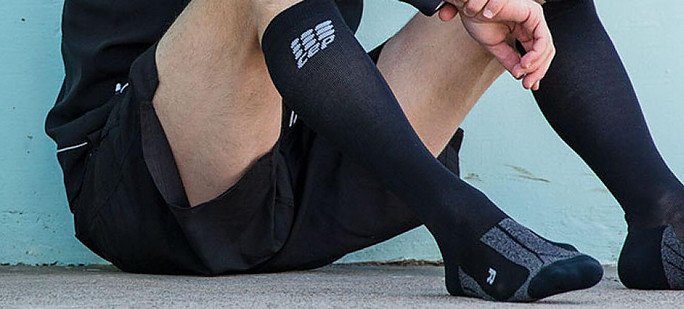Here we review one of the popular compression socks called CEP Compression Socks to find out can diabetics use Cep compression socks? This CEP compression socks review will also confirm when you should not use these socks as a diabetic.
Let’s start rolling by finding out what CEP socks really are.
What are CEP Compression Socks?
CEP is an internationally renowned company that was founded in 1951. It is a brand of medical and healthcare product company that also produces compression socks. CEP manufactures active compression sportswear. Not only that CEP also produces a wide range of products like shorts, tights, socks, and shirts which can be used for running, training, hiking, etc.
These compression socks are used to remove metabolic wastes such as lactates, and also for improving blood circulation. Every athlete using CEP compression socks stands to achieve a balance between health and performance.
The CEP company reassures that their compression socks are produced with a good collaboration from scientists, athletes, physicians, and designers.
Benefits of CEP Compression Socks
- Improved circulation
CEP compression socks can help to increase the supply of oxygen and nutrients to the muscles. This will help the muscles gain more power and endurance.
- Improved stabilization
CEP compression socks activate skin receptors. This will help to increase muscle tension and also improve the sense of position in the body.
- Heightens recovery
CEP compression socks help to remove the metabolic waste products that contribute to foot injuries. After removing the metabolic waste products, it will also replenish the energy which was lost to enable faster recovery.
- It has a great anatomical design
CEP is designed to have a great fit. The anatomical fit will serve as protection to your feet. It will also help to prevent blisters by acting as a second skin to your leg.
- It has smart infrared
CEP is made with yarns that have bioactive materials. The bioactive materials synchronize with the body’s infrared radiation, giving room for a natural recovery process.
Tip: Diabetic socks are not the same compression stockings.
Types of CEP Compression Socks
These compression socks are designed for both men and women. You are to choose your CEP compression socks based on your gender. This will enable you to choose the right one, which helps in stabilizing your joints.
Cep Compression Socks for Men
- Tall compression socks 3.0 for men
- 80’s mid-cut compression socks for men
- 90’s tall compression socks for men
- Short compression socks 3.0 for men
- Outdoor Merino mid compression socks for men
- Commuter tall compression socks for men
- Outdoor Merino Tall compression socks for men
- Trial Merino Tall compression socks
- Ski Thermo Tall compression socks for men
- Ultralight Tall compression for men
- Ultralight short compression socks for men
- Ultralight No show compression socks for men
- Ultralight Low Cut compression socks for men
- Old Glory Tall compression socks
- Old Glory mid-cut socks for men
- Neon Tall compression socks for men
CEP Compression Socks for Women
- 80’s Tall Compression socks for women
- 80’s mid-cut women compression socks women
- Tall compression socks 3.0 for women
- Short compression socks 3.0 for women
- Low cut compression socks 3.0 for women
- Ultralight Tall compression socks for women
- Ultralight short compression socks for women
- Ultralight Low cut compression socks for women
- Ultralight No show compression socks for women
- Tall compression socks for recovery
- Old glory Tall compression socks for women
- Old glory mid-cut socks women
- Outdoor Merino Tall compression socks for women
- Outdoor Merino mid-cut compression socks
- Commuter Tall compression socks for women
- Tall Merino mid-cut compression socks for women
- Ski Thermo compression socks for women
- Trial Merino Tall compression socks for women
- Neon mid-cut compression socks for women
This is how to wear a compression sock.
Do CEP Compression Socks Contain Copper?
CEP compression socks do not contain copper. It is not a copper sock. Some compression socks contain copper, but they have the same benefits as normal compression socks like CEP. The only proven extra benefit that copper compression socks provide is that is very efficient in fighting odor.
The Best CEP Compression Socks Review
80’s Tall Compression Socks
Features
- Has compression level of 20-30mmHg
- Made up of 85% Polyamide and 15% Spandex.
Benefits
- Has a graduated compression
- Has skin cooling property due to HEIQ clima management
- It recovers sore calves very fast
- It removes lactic acid efficiently
- It has superior moisture-wicking fibers which help in keeping the skin fresh
- These compression socks help In pain relief, especially in those having plantar fasciitis, shin splints, and Achilles tendons.
80’s Mid-cut Compression Socks
Features
- It has a compression level of 20-30 mmHg
- It is made of 88% polyamide and 12% spandex
Benefits
- It helps to relieve swelling and soreness
- Along with the foot-bed, there is a performance padding which helps to prevent blisters.
- It has a skin-cooling effect due to the HEIQ clima managements
- It is perfect for all sports and activities due to its crew length height
- It is very tough and durable due to its breathable yarns
- It relieves pain, especially that caused by plantar fasciitis.
Tall Compression Socks
Features
- Has compression level of 20-30mmHg
- Made up of 85% Polyamide and 15% spandex
Benefits
- Has a graduated compression
- Has skin cooling property due to HEIQ clima management
- It recovers sore calves very fast
- It removes lactic acid efficiently
- It has superior moisture-wicking fibers which help in keeping the skin fresh.
- These compression socks help In pain relive especially in those having plantar fasciitis, shin splints, and Achilles tendons.
Short Compression Socks 3.0
Features
- It has a compression level of 20-30 mmHg
- It is made of 88% polyamide and 12% spandex
Benefits
- It helps to relieve swelling and soreness
- Along the foot bed, there is a performance padding which helps to prevent blisters.
- It has a skin-cooling effect due to the HEIQ clima managements
- It is perfect for all sports and activities due to its crew length height
- It is very tough and durable due to its breathable yarns
- It relieves pain, especially that caused by plantar fasciitis due to athletic compression.
Low Cut Compression Socks 3.0
Features
- It has 89% polyamide
- It is 11% spandex
Benefits
- It helps to relieve swelling and soreness
- Along with the foot bed, there is a performance padding which helps to prevent blisters.
- It has a skin-cooling effect due to the HEIQ clima managements
- It is perfect for all sports and activities due to its crew length height
- It is very tough and durable due to its breathable yarns
- It relieves pain, especially that caused by plantar fasciitis due to the sock’s athletic compression.
Summary of CEP Compression Socks Review
When you have an injury in foot muscles (e.g. sprain) you need to have a good rest and suspend your activities until you recover. For some, this can be cumbersome, but with the introduction of CEP compression socks, getting foot relief and recovery is as simple as slipping in a pair of socks.
The reviews of CEP compression socks will be summarized based on fitness, appearance, and purpose.
- Fitness
The first thing to note about CEP compression socks is that it will be very tight. The moderate tightness is what helps to strengthen the calf and improve circulation. Compression socks are always well fitted if you buy the one that suits your leg. To get this, you need to have your calf measured.
When you get your size, putting them on the first time can appear complicated and stressful, but with consistent wear, it becomes an easy thing to do. If you are new to CEP compression socks, because of the tightness, you might be able to just read them for a short period.
With consistency, you will get used to it and start wearing them for a longer period. You will also get comfortable with it and notice that your legs will start feeling less fatigued.
- Appearance
CEP manufacturers are fashion conscious. This is why you will notice that they are highly designed in a variety of colors which makes them fashionable.
- Purpose
CEP compression is designed to give you all the comfort you need. This is very beneficial to those who have any form of venous disorder or health problem.
When Should Diabetics Not Wear CEP Compression Socks?
Diabetics should not wear compression socks if the compression level is too high. Most diabetics usually have a circulation problem which is a result of diabetic neuropathy.
Compression socks help to solve this circulation problem to a great extent by squeezing the foot and calf muscles, thereby straightening the vein walls to function better. This compression will see to the proper functioning of the valve, by opening to allow blood flow towards the heart, and closing to prevent blood from flowing back.
Have in mind that, although compression socks help in circulation, each sock has different compression levels measured in millimeters.
Diabetics should not use CEP compression socks with a high compression level.
There is light compression which ranges from 8-15mmHg and extra firm compression which ranges from 40-50mmHg.
Tip: There is no exception for MediPeds Compression Socks either.
Dangers of Using Tight Compression Socks in Diabetics
For diabetics, they should avoid using compression socks, if they have skin that is easily irritated or if the socks are not properly fitted. If they go-ahead to wear socks that are not properly fitted, any of these might happen.
- The compression socks can cut off your circulation
The sole aim of compression socks is to provide continuous pressure that supports circulation. This effect can only be gotten the socks are properly fitted. If the socks don’t fit properly, you might have your circulation cut off.
- The socks can bruise your legs
For those with dry skin, compression socks can cause you to have bruises on your legs. They can also experience these cuts or scars when they are traveling in dry air. This only happens when the socks are not well fitted.
- The socks can cause itching or redness.
When you are putting on ill-fitted compression socks, it can cause you to have skin itching or irritation.
Moreover, as a diabetic, when you are using compression socks, and you notice any of these, you should stop immediately and consult your doctor.
- When you start having swollen or hard veins
- When you have persistent leg cramps
- When you start noticing a bluish or purple skin
- When redness starts to appear in one area of your vein
- When you start having difficulty breathing
- When you start noticing a bluish or purple skin
What are The Best Ways To Use Compression Socks?
If you are using CEP compression socks, especially as a diabetic, you have to use them the right way to avoid complicating your health issues further. The best ways to use them include
- Ensure that your fitted compression socks are chosen by a professional
- Monitor your weight. If you add or reduce weight, you should change your compression socks to fit your new weight.
- Carefully follow the instructions given by the socks manufacturers.
- Monitor your skin for changes like redness or chaffs
- Ensure that you hand wash your socks to prevent the fabric from warping.
- Once you notice that your compression socks are losing their stretch, endeavor to change them
- The recommended wears for each sock is 30 or fewer days/times.
- Ensure that you change your compression socks daily with a clean, dry pair.
Can You Sleep in CEP Compression Socks?
This question depends on who is asking. If you are a healthy person without any health or foot complications, then the answer is No. On the other hand, if you are having a health issue, depending on what you discussed with your health care provider, you can wear your compression socks to sleep.
During the day, you are in an upright position, while at night you are in a horizontal position. For those with a venous disorder, it is always hard for your blood circulation and veins to function effectively. This is why graduated compression socks function to constantly provide pressure. This pressure helps the circulatory system to fight major disruptions in blood flow. Wearing this during the day while you are active will give the needed effect. Whereas wearing it at night will put so much pressure on your legs while you are sleeping because you are not active at that point.
If at all you should wear compression socks at night, it should be low compression socks of 8-15mmHg.
How Do You Wash CEP Compression Socks?
The CEP management states that their products require low maintenance. This means that you just need to put in a small effort correctly.
How to effectively wash your CEP compression socks include;
- Immediately after use, wash your CEP compression socks
- Use a machine to wash with a delicate cycle of 40°c
- Avoid using bleach to wash
- If you are to dry, do that with a low temperature
- Do not dry in direct sunlight or radiator
- Don’t iron your compression socks to avoid losing their stretch
- Avoid dry cleaning.
Conclusion
For athletes and people with diabetics, compression socks are very much recommended. However, before you buy any compression socks, or before you start using any compression socks, ensure that you speak with your health care provider. Don’t ever wear ill-fitted compression socks. Always take adequate measurement of your calf before you start using any compression socks.
Tip: Here’s our Nano Socks review.









